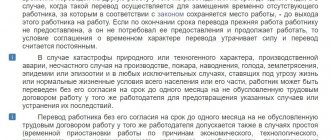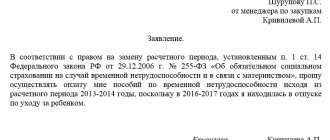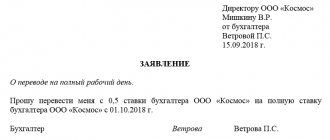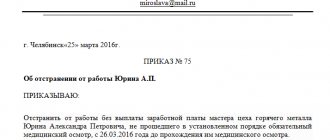Home / Labor Law / Vacation
Back
Published: June 20, 2016
Reading time: 8 min
0
5151
When an employee goes on vacation, his duties are performed by his deputy.
If such a staff position is not provided, and the work must continue, the functions of the vacationer can be transferred to another employee.
- Legislation
- Combination Additional payment
- Decor
- Payment
Performing the duties of a temporarily absent employee
There are several ways to replace vacationers:
- Combination. The employee combines his own work and the work of a vacationer (Article 60.2 of the Labor Code of the Russian Federation).
- Temporary transfer. The employee performs only the duties of a vacationer (Article 72.2 of the Labor Code of the Russian Federation).
- Part-time job. The employee spends time free from his main job on vacation work (Article 60.1 of the Labor Code of the Russian Federation).
- Hiring a temporary employee. An employee is hired with the conclusion of a fixed-term contract for a period corresponding to the vacation period of the replaced employee (Article 59 of the Labor Code of the Russian Federation).
Temporarily absent and temporary employees: legislation
Orders and report cards are the main documents where information regarding citizens is recorded after hiring. Based on this information, remuneration for labor is then determined.
If an employee is absent from the enterprise, a note is added to the passport. It gives a detailed description of the grounds, but this does not amount to the right to dismiss. The State Statistics Committee of the Russian Federation issued Resolution No. 1, which describes the coding for various reasons for absence. From the necessary information, note the description of the maintenance of salary for the period, or its absence.
Temporarily absent are those who have been absent from work for some time for serious reasons. That is, current legislation is not violated.
At the stage of company creation, management develops staffing schedules. They tell you how many people are required to complete a particular task in a certain time. A one-time absence of a subordinate does not cause serious damage. It’s another matter when the time period of such an event is long. Therefore, laws allow the registration of another person for the same position.
Expansion of responsibilities or combination
If one employee goes on vacation, another may be assigned to perform his duties without releasing him from his main job. This work may correspond to his position or not (Article 60.2 of the Labor Code of the Russian Federation).
If the additional work is similar to the employee’s work, this is an expansion of responsibilities; if not, it is a combination.
Is a full-time deputy manager entitled to additional payment if the manager goes on vacation and his responsibilities are assigned to the full-time deputy? The answer to the question is debatable, because according to the official duties of the deputy. must “pick up” the manager’s affairs during his absence. Find out the authoritative opinion of a ConsultantPlus expert by getting free trial access to the system.
An employee cannot be forced to perform additional work. The employee must give written consent to this.
Additional payment for performing the duties of a temporarily absent employee is specified in an additional agreement and can be made for actual work performed or calculated in proportion to the time worked (Article 151 of the Labor Code of the Russian Federation). The combination order must indicate how the replacement is paid for during the vacation and the period for which it is issued.
Each party to the employment relationship may terminate it early. To do this, the initiator of termination must notify the opposite party in writing 3 working days in advance.
How to correctly draw up an order for combining positions, read the article “Order for combining positions - sample for 2020-2021.”
But it may happen that no one receives additional payment for an absent employee. This happens when an employee replaces a colleague with similar job functions and his job description clearly stipulates such substitutions. In this case, the employee’s written consent is also not required.
What you need to pay attention to when attracting part-time employees of your organization, read the article “Registration of combining positions in one organization.”
Example
LLC "Cuckoo" In January, the cashier goes on vacation for 14 calendar days (10 working days). During his vacation, a second accountant agreed to perform his duties.
An order is issued to combine positions. It states that the additional payment for combined work will be calculated in proportion to the time worked.
The accountant's salary is 20,000 rubles.
The cashier's salary is 17,000 rubles.
We calculate the amount of payment for one working day: 17,000 rubles. / 17 days (number of working days in January) = 1000 rub.
The amount of additional payment for 10 working days was: 10 days. × 1000 rub. = 10,000 rub.
Total, in January the accountant will receive a salary of 20,000 rubles. + 10,000 rub. = 30,000 rub.
From this amount it is necessary to withhold personal income tax (13%) and pay contributions.
How to pay
During a temporary transfer, the employee is entitled to additional payment for the absent employee: according to the Labor Code, he must receive money for the work performed. Therefore, this method is usually used when replacing managers whose salaries are higher than those of ordinary employees.
In the case of combining positions, a person is given an additional payment for replacing him during the vacation of the boss or another employee. A specific additional payment for replacing a temporarily absent employee (Labor Code of the Russian Federation) is established by agreement of the parties (Article 151 of the Labor Code of the Russian Federation).
When increasing the volume of work or expanding the service area, the amount of additional payment and the amount of additional work are also determined by agreement of the parties.
Execution and payment of temporary transfer
It happens that the combination cannot be performed. In this situation, the employer has the right to release the employee from his current duties and transfer him to the vacationer’s workplace. The transfer period corresponds to the vacation period of the absent employee (Article 72.2 of the Labor Code of the Russian Federation).
Transfer is possible only with the written consent of the employee. The additional agreement to the employment contract specifies the terms of the transfer. After this, a transfer order is issued.
You will learn what to pay attention to when drafting it from the article “Order to transfer an employee to another position - sample.”
After the transfer is completed for the employee, this workplace becomes the main one, and, therefore, he must undergo all the training, like other employees.
The work book does not reflect the transfer and return to the main place of work.
Additional payment for performing the duties of a temporarily absent employee occurs in the amount specified in the additional agreement.
Upon return to work of the main employee, it is necessary to send a notice to the replacement employee about the end of the transfer period and draw up an order to terminate the duties of the temporarily absent employee.
If the transfer period has expired and the employee is not given the opportunity to return to his main job and he has not demanded his reinstatement to it, then the agreement on the temporary transfer becomes invalid. Temporary work becomes the main one.
Filling a vacant position - what is it, how does it differ from a combination
Everyday life is not always stable and monotonous. Emergency situations often arise that interfere with the ordinary performance of citizens’ work activities.
For example, a sudden illness or a decision to quit work. As a result of such circumstances, a certain amount of work arises at the enterprise that requires execution even in the absence of the main personnel.
To achieve this, management resorts to replacing and combining positions.
The essence of filling a vacant position
Based on the provisions of Federal Law No. 79 of July 27, 2004.
, filling a vacant position of an absent employee is a procedure for replacing an employee who is not at his workplace for a number of reasons with another entity, based on the decision of the head of the company to transfer the duties of the absent person to his colleague or temporarily hired entity. In this case, the subject who replaces his absent colleague is completely relieved of his main job responsibilities and receives a salary in the same amount as it is assigned to the new position.
When replacing one employee with another, the salary can only be increased, but it is illegal to assign the replacement entity a payment that is less than what the main staff received.
Also, a special nuance of such a procedure is the period during which the subject must perform someone else’s duties. It is assumed that the same employee should not work outside his profile for more than 31 days.
If, after this period, the temporarily absent subject has not returned to the workplace, the replacement person must nevertheless return to his direct professional tasks as specified in his employment agreement.
Substitution is often practiced in standard offices when an employee registers temporary disability, goes on annual leave or leave at his own expense. However, if the conditions of the production process are harmful and/or dangerous, substitution may be resorted to for the following purposes:
- prevent the onset of an emergency (accident, equipment breakdown or any other technical disaster);
- eliminate the consequences of a natural disaster;
- prevent accidents at work;
- eliminate the possibility of damage or destruction of materials and equipment, as well as any other property owned by the company;
- establish a stable production process, thereby leveling the company’s economic position.
Ways to perform the duties of a temporarily absent employee
The labor legislation of the Russian Federation provides for the following possibilities for the performance of the duties of a temporarily absent employee by another person:
- Entrust the corresponding job responsibilities of the temporarily absent subject to a full-time employee of the organization, completely freeing him from his main activity profile.
- Offer a full-time employee or a subject employed by another company to perform such temporary duties, combining them with the main job tasks. This implies a specific task, several tasks in a limited number, after completing which the employee is removed from such a position until the return of the main staff.
- Design
- Entrust temporary duties to another part-time employee. It is assumed that a particular employee during the working day will perform not only his duties, but also the functions of a temporarily absent person. Moreover, such work continues throughout the absence of the main subject.
Combination of positions - what is it?
Combination is an increase in the volume of labor responsibilities of a particular subject by the amount of the same responsibilities of another position.
In fact, combining vacancies represents the acquisition of additional workload without interruption from the main work activity. For such work, the subject is also expected to receive additional remuneration.
At the same time, filling a position is a complete release from the usual duties of the subject while working in a different profile.
It is also necessary to understand the difference between combining positions and professions. Combining positions represents the performance of duties in the field of management, special work of highly professional specialists, as well as employees. The combination of professions, in turn, is the performance of job duties in the field of work orientation.
So, if a manager decides to involve an employee in additional work without taking him away from his main activity, he needs to:
- agree on adjustments to the staffing table;
- approve and formalize the employee’s consent;
- draw up an additional agreement;
- publish an order to prove the legality of this procedure.
The procedure for registering the replacement of a temporarily absent employee
The procedure for registering a replacement frame that is missing for some reason is as follows:
- Based on Art. 72 of the Labor Code of the Russian Federation, replacement is formalized with the written consent of the subject who is entrusted with new temporary responsibilities.
- In accordance with Art. 59 of the Labor Code of the Russian Federation, if the labor of a temporarily hired employee is used, he must draw up a fixed-term employment agreement with a clear indication of the period of employment.
- All additional responsibilities, in addition to the entrusted new work tasks, are imposed on the employee only with his written consent. They must also be formalized through an additional agreement or in the text of the main employment contract upon its conclusion.
Source: https://kfin.pro/zameschenie-vakantnoy-dolzhnosti-chto-eto-takoe-chem-otlichaetsya-ot-sovmescheniya/
How to register and pay for a part-time job
If expanding job responsibilities is impossible, the employer can arrange a part-time job (Article 60.1 of the Labor Code of the Russian Federation).
Part-time work is the performance of additional duties in your free time from your main job. But this time is standardized and should not exceed half of the monthly working time norm. It is the employer’s responsibility to ensure that this standard is not exceeded. All other functions remain unchanged (Articles 282, 284 of the Labor Code of the Russian Federation). Internal part-time work is formalized by concluding a separate employment contract.
Read more about external part-time work in the article “How to properly arrange external part-time work?” .
Payment for part-time workers can be made in proportion to the time worked or for the amount of work actually completed. This must be reflected in the employment contract.
Example
At the Lukoshko store in February, the cashier went on vacation for 14 calendar days (10 working days). During his vacation, a part-time worker was appointed to take his place.
The salary for a combined position is 15,120 rubles.
We calculate the amount of payment for one working day: 15,120 rubles. × 50% / 18 days (number of working days in February) = 420 rubles.
The amount of payment for 10 working days was: 10 days. × 420 rub. = 4200 rub.
From this amount it is necessary to withhold personal income tax (13%) and pay taxes to the funds (30%).
ConsultantPlus experts provide separate explanations on combination issues.
Get trial access to the system and find out the answers for free.
➤How does substitution differ from combination in ②Ⓞ①⑧
The concept of “human factor” exists for a reason: in any office, an important employee can get sick, quit or go on vacation, and in this case it turns out that there is no one to cope with urgent work.
In a situation where there are not enough workers in an office or enterprise, management can arrange for replacement or combination of professions. Contrary to misconception, these terms do not mean the same thing.
How should each of them be interpreted and how does substitution differ from combination?
According to the Labor Code of the Russian Federation, combining professions is “an expansion of service areas, an increase in the volume of work.”
In practice, this means an additional burden on a certain employee, and the new actions that a person combining two occupations will have to perform may not coincide with the actions originally prescribed in the employment contract.
That is, a person, as it were, gets another vacancy in his company - and, of course, receives a good reward for this. At the same time, he does not sign another employment contract and performs new duties during the working day - in his free time from the main workload.
When discussing work in two directions at once, one should distinguish between the terms “combining professions” and “combining positions.”
- The first is used to designate working specialties.
- The second applies mainly to management, as well as specialists and employees.
We can talk about combining professions if a person works, for example, as a carpenter and a painter, or about combining positions - if he is a manager and deputy head of a department rolled into one.
Despite the fact that an employee who decides to combine professions or positions should not enter into an employment contract again, such an initiative must be formalized.
If a boss wants to invite a subordinate to take on additional responsibilities, he must:
- coordinate changes with the staffing table;
- ask the employee to write an agreement;
- draw up a separate certificate of changes - it must be attached to the original contract;
- confirm the agreement by issuing an order.
What is substitution
In regular practice, there is such a thing as filling positions. What kind of phenomenon this is is stated in the Federal Law of July 27, 2004 N 79-FZ, but if you convey the essence in simple words, you get something like this:
The replacement of an employee is formalized if management decides to temporarily “transfer” a person from one position to another. In this case, the subordinate is released from the duties that he was originally assigned, and receives for the work the same amount as the absent colleague previously received.
The salary of the “replacement” may even be increased, but in no case reduced.
An important nuance: the same employee cannot replace another for several months in a row. After 31 days of such work, the person returns to the duties specified in his employment contract.
Most often, the replacement of an employee is arranged in ordinary offices when one of the team members goes on vacation or falls ill. However, if we are talking about hazardous production, the criteria change, and in this case, substitution is resorted to in order to:
- prevent an accident or even a disaster;
- eliminate the consequences of a natural disaster;
- prevent an accident;
- avoid destruction or damage to property;
- ensure the economic stability of the company.
Difference Between Combination and Substitution
Having carefully understood what substitution and combination are, we can conclude what is the difference between these concepts. To do this, you should pay attention to factors such as:
- employee workload;
- wages;
- maximum period.
A person who combines two professions or positions experiences a much greater burden than a substitute.
Combination implies, as it were, two jobs at once, and substitution is only one type of activity, simply not specified in the main employment contract with the employee.
However, double work is paid accordingly. But when replacing professions, it is as if the employee “exchanges” his salary with a person who got a job in another vacancy - and even then not for long.
As for combining positions, an employee can hold two vacancies at once in one company as long as he likes: the additional agreement may not specify any term (however, sometimes it is still set). Moreover, if management decides to remove a subordinate from the second position or reduce his remuneration, the person must be warned about the upcoming changes at least two months in advance.
What is more profitable to offer to an employee in each specific case - replacement or combination - is decided by the management. But in any situation, you should not decide everything for the performer in advance or force him to change his occupation, even for a short time. The employee must be aware of all the specifics of the case and sign the agreement, being confident in his own abilities.
comparison table
So, we figured out what substitution and combination of professions (or positions) are and what are the similarities and differences between these concepts. For convenience, the data can be systematized.
CombinationSubstitution
| Load | Double: a person performs the duties dictated by the employment contract, and in his free time - the duties dictated by the additional agreement. | The person fulfills the duties dictated by the additional agreement. |
| Salary | The salary stipulated according to the employment contract, plus a pre-agreed amount as an additional payment. | Salary of a person who is absent from the enterprise (allowances are possible). |
| Maximum term | Is not limited | One month during the calendar year. |
Part-time and combination:
Source: https://ligabiznesa.ru/kadry/sovmestitelstvo/zameshhenie-i-sovmeshhenie.html
Hiring a temporary employee
Another way to replace an employee who has gone on vacation is to hire a new employee in his place by concluding a fixed-term contract with him (Article 59 of the Labor Code of the Russian Federation).
This replacement method will be preferable for enterprises that have technically complex positions. And if you try to combine them, the entire labor process may suffer. For example, this could be a large manufacturing enterprise. The adjuster of technically complex equipment goes on vacation. The advantages of hiring a temporary employee are obvious: the manager gets a full-time employee, and the work process does not stop.
Payment, conditions and duration of work are negotiated and indicated when concluding a fixed-term employment contract.
Establishment of additional payment for combining positions
Combined positions are paid according to the Labor Code, which contains clear standards for the minimum fixed amount of compensation. The boss is not limited in determining the additional payment, and has the opportunity to determine it together with the employee, taking into account the nature of the work and its complexity. But it cannot be less than half of the basic salary provided for this position.
There are several types of reward:
- As a percentage - the most common method, which involves payment of 30, 50, 80% of the salary or another ratio depending on the agreements of the parties.
- Fixed amount - implies a one-time payment determined by the employer in a fixed form for time off during the vacation period of one of the employees.
Additional responsibilities are labor and should be rewarded accordingly. The employer makes the calculation independently, but takes into account the effort expended, the complexity of the work and the number of tasks completed. If an employee worked part-time, then the person who replaced him receives a salary in the same amount.
Results
If an employee goes on vacation at an enterprise, then a replacement will most likely need to be selected to take his place. There are several options for such a replacement. Choose the one that is convenient for you. But no matter which one you choose, remember that the obligation to make additional payments for performing the duties of a temporarily absent employee cannot be neglected.
Sources: Labor Code of the Russian Federation
You can find more complete information on the topic in ConsultantPlus. Free trial access to the system for 2 days.
Position filling
The employee’s labor function (work according to the position in accordance with the staffing table, profession, specialty indicating qualifications, the specific type of work assigned to the employee) is named in the employment contract. Additional work assigned to an employee in another profession (position) can be carried out by combining professions (positions). Today we will consider the situation of combining work in one institution.
It is necessary to distinguish between the concepts of “combination” and “substitution”. So, combining means that you simultaneously perform both your job responsibilities and the responsibilities of an absent employee within a standard working day. Substitution provides for the performance only of the duties of the absent employee (hence the wording “acting”).
When combined, there is an additional payment to your basic salary.
N CAS 03-25, this subclause is declared invalid to the extent that it prohibits the payment of the difference between the official salaries of an absent employee and his full-time deputy or assistant, as well as the chief engineer of an enterprise, institution or organization.
Thus, at the moment, a full-time deputy has the right to receive additional payment for combining positions in the amounts established by agreement of the parties.
Temporary performance of duties in the position of an absent employee, as well as combining professions (positions), is assigned to another employee by order (instruction) of the manager.
The order specifies the position for which the employee will perform the work, the volume and timing of the work performed, and the amount of additional payment.
Labor Code of the Russian Federation). Moreover, a valid reason is not required. According to Art. 21 of the Labor Code of the Russian Federation, an employee has the right to payment of wages in full in accordance with his qualifications, complexity of work, quantity and quality of work performed. By virtue of Art.
135 of the Labor Code of the Russian Federation, an employee’s salary is established by an employment contract on the basis of the remuneration systems in force for a given employer.
Remuneration systems, including tariff rates, salaries (official salaries), additional payments and allowances of a compensatory nature, including for work in conditions deviating from normal, systems of additional payments and incentive allowances and bonus systems, are established by collective agreements, agreements, local regulatory acts in accordance with labor legislation and other regulatory legal acts containing labor law norms.
Filling a vacant position
This article describes in detail about filling a vacant position, and everything you need to know about it.
Some suggest that filling a vacant position is the fulfillment of the labor obligations of a temporarily absent specialist. But this is not true at all.
But what is filling a vacant position, why is it needed and the procedure for holding a competition. These questions have been relevant for a long time for those who want to get a job.
What is filling a vacant position?
Filling a vacant position is not taking the place of a temporarily absent employee, but concluding an employment contract between the employer and the prospective employee for the fulfillment of labor obligations. In other words, filling a vacant position involves hiring a new employee for a position that is vacant, for example, due to the dismissal of another employee.
The vacant position itself is the fulfillment of labor obligations, for which the employee will receive a good salary and have the opportunity to advance up the career ladder.
The difference between a vacant position and a simple one is the possibility of rapid career growth and high pay. In addition, in large cases, such a position is called specialization in government bodies.
Legislative regulation of filling a vacant position
In accordance with the Labor Code of the Russian Federation, a vacant position is filled on the basis of a competition, which may include:
Interview with the candidate;
Research of the candidate's documents;
Psychological testing of the candidate for stress resistance;
Testing the candidate for basic knowledge and skills in the specialty.
The employment of a specialist for a vacant position through competition occurs in accordance with the Labor Code of the Russian Federation, and in particular in accordance with Articles 16, 18.
In addition, the filling of vacant positions in government bodies is regulated by Presidential Decree No. 112, adopted in February 2005, which was amended in 20017.
Filling a vacant position in government agencies
In accordance with the decree of the President of the Russian Federation number 112, any citizen of the Russian Federation has the right to fill a vacant position. The introduction of a competition for filling a position is adopted by order of the head of the state unit. There is no need to hold a competition in the following cases:
- If the replacement occurs for a short period of time, during the absence of the main employee occupying this position;
- If the appointment of a manager occurred on the basis of a decree of the President of the Russian Federation;
- If a civil servant was appointed to a position in connection with a transfer from another place of work;
- If an employee who is in the state personnel reserve is appointed to the position;
- If the position is small, it does not require special knowledge and skills from the candidate.
All adult citizens of the Russian Federation who have the knowledge and skills that meet the requirements for the candidate have the opportunity to take part in the competition. The competition must be held in 2 stages:
- Posting information about a competition to fill a vacant position;
- Direct holding of the competition.
At the first stage, the employer accepts applications for participation in the competition, as well as relevant documents, which include:
- Application, questionnaire;
- A copy of an identity document;
- Diploma of secondary or higher education, copy of work book;
- A certificate from a medical organization confirming that the candidate has no dangerous diseases;
- Other documents established by law.
After submitting all documents, HR specialists examine them within a month and make a decision on the possibility of candidates participating in the competition. After which the candidate is required to be notified.
The second stage is the direct holding of the competition, on the basis of which one candidate is selected. He will subsequently occupy the vacant position. If this candidate refuses this position, then the participant in the competition who took second place is called in his place.
Competition for a vacant position is a good opportunity for a recently graduated specialist to get a good job.
If he successfully passes all stages of the competition and shows a high level of knowledge and skills, he is selected for the position, even if more experienced candidates participated in the competition. Experience is not always an indicator of performance.
Sometimes, a person who has not officially held a position knows the specifics of the work better than the head of the enterprise. And a person who has worked at an enterprise for many years simply forgets all the subtleties of fulfilling labor obligations.
In this article you learned about filling a vacant position. If you have any questions or problems that require the participation of lawyers, then you can seek help from the specialists of the Sherlock information and legal portal. Just leave a request on our website and our lawyers will call you back.
Editor: Igor Reshetov
Personnel registration
Both the performance of certain duties and the payment of remuneration for work performed are possible only on the basis of administrative documents - the same orders. Therefore, before an employee begins additional tasks, it is necessary to document his admission and the amount of additional payment.
Notification
That is, at the initial stage, the line manager draws up a memo or report stating that the main employee is going on vacation, therefore, in order to avoid downtime, it is necessary to assign his responsibilities to one or another worker.
After imposing a resolution on the specified document, the employee is sent a notification with a proposal to expand service areas during the vacation of the vacationer according to the following sample:
Is an application required?
As a rule, many workers seek to increase their income through even temporary part-time jobs.
Therefore, if one of them goes on vacation, the workers themselves can initiate the combination in the form of an application with a request to be assigned additional responsibilities.
A sample application can be found below:
Order
Naturally, on the basis of an application or notification, which actually serves as the basis, an order is issued to assign responsibilities or expand service areas.
The standard form is presented on our website:
Additional agreement
Under Article 60 of the Labor Code of the Russian Federation, an employee cannot perform duties that are not covered by the employment contract.
Accordingly, in order for the worker to receive certain powers and to know what his new responsibilities are, even on a temporary basis, an additional agreement is drawn up.
A typical form looks like this:
Forms can be downloaded here:
Order form for combining positions
Additional agreement on combining positions
Application for combining positions
In what cases is sick leave not paid? This is discussed in our article. How to issue an order to postpone annual leave? Find out here.
Reflection in other personnel documents
As a rule, employment in one of the positions implies an indication in other personnel documents, in particular, in a report card or personal card, but not in the case of a combination.
The reason is that the employee performs duties in two positions simultaneously during the same shift and is not transferred to another vacancy.
Payment amount
In 1981, Resolution of the USSR Council of Ministers No. 1145 was adopted, which has now lost force, which does not prevent many companies from using it as a base.
That is, many employers to this day set an additional payment of no more than 50% for blue-collar workers, and up to 30% for specialists.
Meanwhile, Article 132 of the Labor Code of the Russian Federation states that remuneration should be made in direct proportion to the quality and quantity of work performed, as well as its complexity.
And since additional responsibilities are also labor, they should be rewarded accordingly, that is, in proportion to the effort expended.
What does it depend on?
Of course, ideally, the percentage of additional payment for performing additional work should depend on the complexity of the work and the number of tasks completed.
However, in practice, management prefers to set a small percentage in the form of an additional payment, thus fulfilling the provisions of Article 151 of the Labor Code of the Russian Federation and no more.
What percentage can be set?
As a rule, in most cases, the additional payment for combining positions during vacation is set at 50%, similar to Soviet times.
However, some employers, in order to save wages, prefer to pay no more than 30% of the vacationer’s salary, citing the fact that this amount of remuneration is specified in the collective agreement.
But it is possible to increase the surcharge, given that the law prohibits providing guarantees lower than those approved by local acts or federal regulations, but making payments in an increased amount is not prohibited.
Calculation features
Often, additional payment for combining positions is made as a percentage equivalent to the salary of the absent employee, but taking into account some features.
If the enterprise is located in the North, the surcharge increases by the corresponding coefficient. If the salary also includes some allowances, for example for secrecy or hazardous working conditions, they are also included.
What to do if an employee takes his vacation in advance and quits? Information on the issue is in the article. How is Chernobyl leave paid? Find out here.
How to understand a pay slip? See here.
Taxes and fees
Remuneration for part-time work is income.
Consequently, from the accrued amount not only personal income tax is charged under Article 208 of the Tax Code of the Russian Federation, but also other fees are transferred, such as insurance premiums in accordance with Article 425 of the Tax Code of the Russian Federation.
Example
Let’s say a vacationer’s salary is 12 thousand rubles. He is also entitled to a monthly bonus for hazardous working conditions of 10%. In accordance with the order, an employee who is employed part-time is given an additional payment of 50%. In this case, the vacationer will remain on vacation for 28 days.
Calculation: 12000 + 10% (1200): 168 (monthly hours) x 160 (hours for 28 days) x 50% = 6285.6 rubles.










